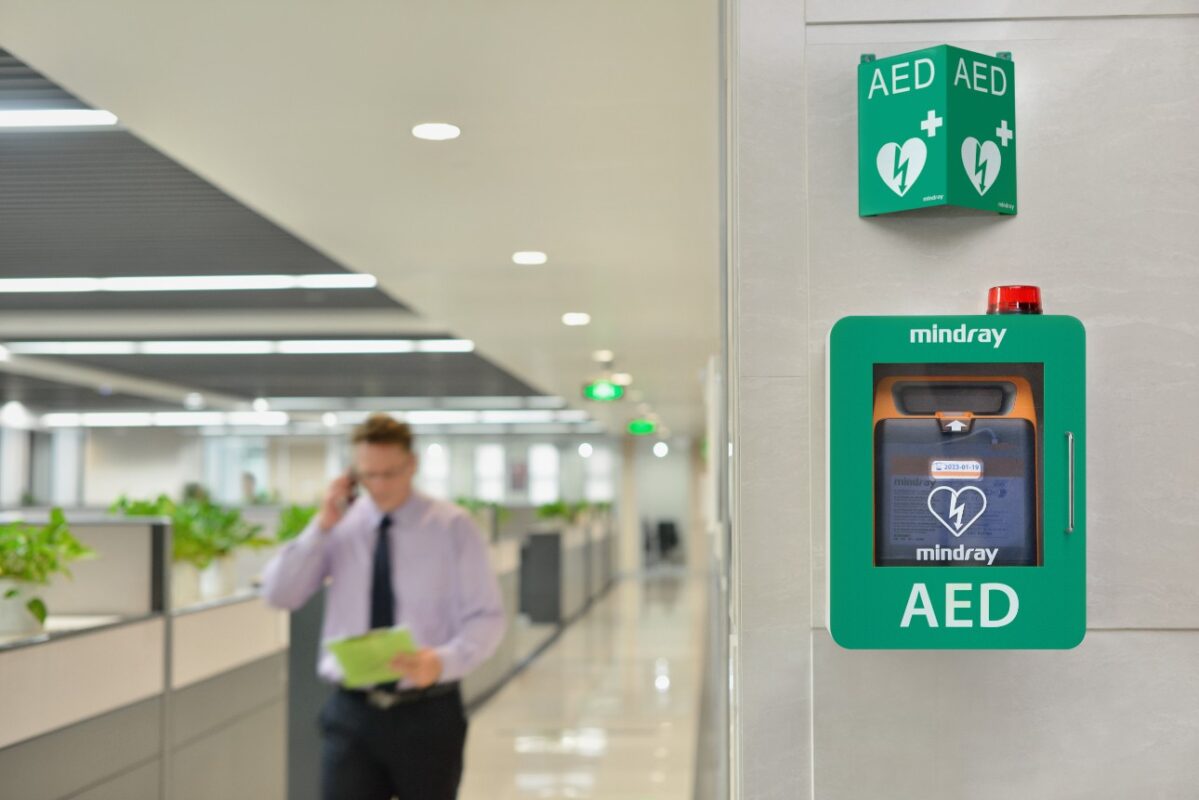No products in the cart.
Uncategorized
Life-Saving Heroes: How AEDs are Making a Difference in Everyday Communities
Every single day, approximately 1,000 Americans suffer from the sudden and heartbreaking occurrence of cardiac arrest, which is one of the leading causes of death. People of all ages can be affected, but communities are actively responding. Many people choose to invest in automated external defibrillators (AEDs) that are easy to use, ensuring they can effectively respond to this potential danger.
Throughout 15 years, AEDs have undergone significant advancements, making them more user-friendly and cost-effective, with an average price of approximately $1,500.
Many people still have misunderstandings about the safety and cost of AEDs, but emergency managers and human resources staff are working to change that. They are making AEDs more common in public spaces, which greatly improves the chances of survival during cardiac emergencies.
Calmed Equipment is here to support your efforts by offering consultation, CPR/AED certification, and maintenance solutions. We understand the importance of effective public access defibrillation programs and are committed to helping you succeed.
Sudden Cardiac Arrest:
Before delving into the impact of AEDs, it’s important to understand the gravity of sudden cardiac arrest. SCA occurs when the heart unexpectedly stops beating, causing blood flow to the brain and other vital organs to cease. Unlike a heart attack, which is caused by a blockage in the blood vessels supplying the heart, SCA is often triggered by an electrical malfunction in the heart.
The survival rate for SCA is significantly higher if immediate action is taken. For every minute that passes without intervention, the chances of survival decrease by 10%. Therefore, the presence of AEDs in public spaces can be a game-changer in the race against time.
The Role of AEDs in Emergency Response:
Automated External Defibrillators are portable devices designed for use by non-medical personnel in emergency situations. AEDs analyze the heart’s rhythm and deliver an electric shock to restore normal rhythm if needed. The simplicity of these devices allows individuals with minimal training to provide life-saving assistance until professional medical help arrives.
One of the key advantages of AEDs is their user-friendly interface. With clear voice prompts and visual instructions, these devices guide even untrained bystanders through the resuscitation process. This democratization of life-saving skills has empowered communities to take a more active role in emergency response.
How does AED work?
Automated External Defibrillators (AEDs) are designed for simplicity, enabling use by individuals with minimal training. The device features clear instructions and visual aids. When activated, the AED provides voice prompts, guiding users in attaching electrodes to the patient’s chest.
It then assesses the individual’s heartbeat, identifying a “shockable” rhythm that the AED can reset. If such a rhythm is detected, the AED delivers an electrical shock to restore a normal heart rhythm. This swift intervention is crucial, as the survival rate drops by 10% per minute after cardiac arrest. AEDs significantly enhance survival chances when used within the critical first minutes.
AEDs in Public Spaces:
Over the past few years, there has been a concerted effort to make AEDs more accessible in public spaces. Airports, shopping malls, schools, and sports arenas are just a few examples of locations where AEDs are now commonly found. These devices are often housed in easily recognizable cabinets with clear signage, ensuring that they can be quickly located during an emergency.
The widespread deployment of AEDs in public spaces is a testament to the growing awareness of the importance of immediate intervention in cases of sudden cardiac arrest. Communities, organizations, and governments are recognizing the need to invest in these life-saving devices to create safer environments for their residents and visitors.
Benefits of having AEDs in the Community:
Introducing Automated External Defibrillators (AEDs) to your community yields numerous benefits, enhancing public safety and well-being.
Rapid Response:
AEDs enable quick and efficient response to sudden cardiac arrest, crucial in a life-threatening situation. Immediate access to these devices significantly increases the chances of survival.
User-Friendly:
AEDs are designed for ease of use, making them accessible to individuals with minimal training. This ensures that bystanders can confidently provide assistance while waiting for professional medical help.
Increased Survival Rates:
The prompt use of AEDs, especially within the first few minutes of cardiac arrest, substantially improves survival rates. Every minute counts, and AEDs play a pivotal role in bridging the gap until emergency medical services arrive.
Community Resilience:
AEDs contribute to building a resilient community by empowering citizens to take action in emergency situations. Increased awareness and access to AEDs foster a sense of communal responsibility for each other’s well-being.
Public Awareness and Education:
The presence of AEDs in the community promotes awareness about cardiac health and emergency preparedness. Educational initiatives and training programs further empower individuals to respond effectively in emergencies.
Strategic Placement:
Installing AEDs in strategic locations, such as parks, schools, and public buildings, maximizes their accessibility. This ensures coverage across various community spaces, reducing response times in emergencies.
Cost-Effective:
While initial costs may be a consideration, AEDs are a cost-effective investment in comparison to the potential cost of lives lost due to delayed response in cardiac emergencies. The benefits in terms of lives saved and community well-being outweigh the initial expenses.
Legal Compliance:
Having AEDs in public spaces aligns with legal and regulatory requirements, demonstrating a commitment to public safety. Many jurisdictions encourage or mandate AED placement in certain establishments.
Integrating AEDs into your community not only saves lives but also creates a more resilient, prepared, and compassionate environment where individuals can actively contribute to the safety and health of their neighbors.
Community Training Initiatives:
Although AEDs are designed to be easy to use, receiving basic training can greatly improve the effectiveness of bystander intervention. Communities across the country have started training programs to teach people how to use AEDs and perform CPR. These programs aim to educate the public and equip them with life-saving skills.
These programs not only give people the tools to effectively respond in emergencies, but also encourage a sense of community responsibility for each other’s well-being.
Training programs typically incorporate hands-on demonstrations, simulations, and guidance on recognizing the symptoms of cardiac arrest. We strongly encourage community members, including teachers, parents, and employees, to actively participate in these programs.
By doing so, we can establish a strong network of first responders who are prepared to take prompt and decisive action whenever the need arises.
Challenges and Opportunities:
Although the widespread deployment of AEDs is a positive development, there are still some challenges that need to be addressed. A key challenge is making sure that AEDs are strategically positioned in areas where there are a large number of people passing through. It is important to regularly maintain and check these devices to ensure they are working properly when you need them.
In addition, it is important to make efforts to decrease any obstacles that may hinder access to AEDs. One important aspect to consider is the cost of AEDs, which can be a challenge for smaller communities or organizations with limited resources.
Collaboration between public and private sectors, along with government initiatives, can be instrumental in addressing these challenges and ensuring the widespread availability of AEDs in areas that require them the most.
The Future of AEDs:
As technology continues to advance, so too will the capabilities of AEDs. Innovations such as smart AEDs, which can provide real-time feedback and connect with emergency services, are already being explored. These advancements have the potential to further enhance the efficiency of AEDs and increase the chances of survival in emergency situations.
Moreover, ongoing research is focused on expanding the use of AEDs to different demographics, including children and infants. Customized devices and protocols are being developed to cater to the unique needs of diverse populations, making AEDs even more versatile and applicable in a variety of settings.
Conclusion:
Automated External Defibrillators have become indispensable assets in our communities, bridging the gap between the onset of sudden cardiac arrest and the arrival of professional medical assistance. Their widespread deployment in public spaces, coupled with community training initiatives, has empowered ordinary individuals to become first responders in times of crisis.
The success stories of lives saved by AEDs serve as powerful reminders of the impact these devices can have. As we look to the future, continued efforts to improve accessibility, address challenges, and embrace technological advancements will ensure that AEDs remain steadfast allies in the quest to make our communities safer and more resilient. By recognizing the potential of AEDs and investing in their deployment and maintenance, we can collectively contribute to a world where every community member has the chance to be a life-saving hero.






